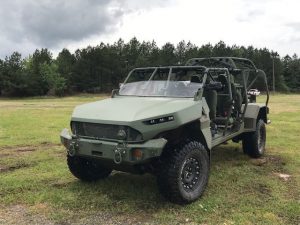A House Armed Services Committee (HASC) panel has proposed requiring the Army to brief lawmakers on the service’s plans for electrification of its ground vehicle fleet and pursuit of an advanced combat engine for the future Optionally Manned Fighting Vehicle.
The HASC Tactical Air and Land Forces Subcommittee’s mark for the fiscal year 2022 National Defense Authorization Act, set to be considered on Thursday, notes the panel is interested in the Army’s progress crafting an initial capabilities document for the tactical and combat vehicle electrification (TaCV-E) initiative and the electric light reconnaissance vehicle (eLRV) prototyping program.

“The committee is aware that the automotive industry is aggressively moving forward with electrification based on mature commercial technologies, including advanced battery technology, and expects the Army to engage with traditional and non-traditional industry entities to accelerate eLRV prototype development and, looking further into the future, also inform the broader TaCV-E initiative,” the panel writes in its mark. “Inherent in vehicle electrification is the potential for operational exportable power generation, making modification of existing tactical vehicles, where appropriate and cost effective, part of the TaCV-E initiative.”
The bill would direct the Army secretary, along with the head of U.S. Special Operations Command, to brief lawmakers on the status of establishing requirements for broader vehicle electrification efforts and plans for the eLRV program, to include details on scheduling, funding profiles and opportunities to accelerate development with the commercial electric vehicle industrial base.
The Army has previously described eLRV as the “first and most promising of developmental opportunities being pursued under the TaCV-E initiative seeking to tackle hybrid or purely electric capabilities for many more combat platforms” (Defense Daily, June 2).
Lawmakers note that the Army’s new Infantry Squad Vehicle and SOCOM’s light tactical vehicles may be suitable candidates for exploration of vehicle electrification opportunities.
GM Defense [GM], which builds the ISV, has showcased an all-electric version of the vehicle that functions as a concept demonstrator for the company’s interest in exploring advanced battery technologies for potential future applications (Defense Daily, May 4).
The subcommittee’s mark also includes a directive for the Army to prepare a separate briefing specifically on the progress of its research and development efforts into vehicle battery recharging in tactical environments.
“Using electric vehicles to replace or supplement the current or future tactical vehicle fleet will require sustained and focused investment in a variety of technical areas not only in fleet electric vehicles but in the capabilities and infrastructure necessary to support them,” the panel writes in its mark. “The concept of tactical charging or recharging is central to the feasibility of the electrification of combat or tactical vehicles. The committee is concerned that research and development of electric vehicle charging or recharging technology should keep pace with research and development of the vehicles themselves.”
The Army last week announced the five competitors it selected to refine OMFV concepts over the next year, with the service planning to ultimately choose a single vendor for production in late FY ‘27 (Defense Daily, July 23).